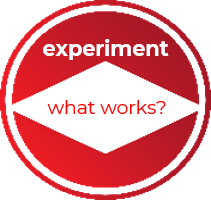Experiment backpack
The purpose of the “experiment backpack” is to support the testing of key assumptions that underlie an idea, concept or business model.
A Strategic Innovation System (SIS) should be able to provide a means to learn whether a solution or feature would work or not for a customer and other key stakeholders as early, rapidly and inexpensively as possible. The quest is to efficiently obtain evidence (data, information, observations or facts) to learn whether a solution or feature is viable for the organization by validating (or invalidating) its desirability, feasibility, defensibility and impact through experiments.
More about it
- It facilitates experimentation activity leading to fast learning and solution validation to a good enough extent, responding to questions such as the following:
- Do users want this solution or feature? If not, what do they want? Or then, who wants this?
- Can we do this reliably? If not, what would be technically and organizationally feasible?
- Can we be the only ones to do this? If not, what would be difficult to copy and imitate? What would be the response of competitors?
- Can we acquire enough customers profitably? If not, what would attract enough customers in an affordable way?
- Should we do/invest in this?
Toolkit
- It includes of tools and techniques such as the following:
- Rapid prototyping (e.g. 2D, 3D or 4D/Living/Working Prototypes) for the purpose of ‛demonstrating’ and validating early, inexpensively and quickly a concept (key assumptions) with stakeholders.
- TRIZ functional modelling for the purpose of ‛demonstrating’ and validating a possible solution system through a depiction (model or ‛2D prototype’) showing its components, relationships, and value creation.
- Business model canvas for the purpose of validating and learning with stakeholders about the ‛whole picture’ of value creation, delivery and capture of an envisioned business concept.

